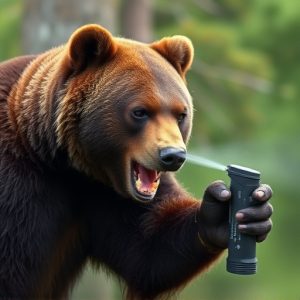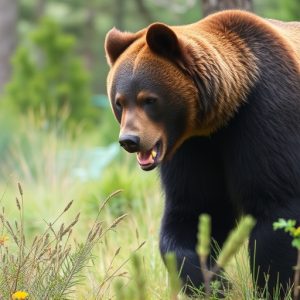Bear Deterrent Spray: Maximum Range, Active Ingredients & Safety
Bear spray, with its higher capsaicin concentration than traditional pepper spray, offers superior p…….
Bear spray, with its higher capsaicin concentration than traditional pepper spray, offers superior protection against aggressive bears in wild environments. It has a longer range (20-30 feet) and is designed to repel larger animals effectively. While both deterrents use capsaicin, bear spray's focus on stronger formulation caters to specific bear encounters. Proper usage techniques ensure maximum potency when facing bears. When comparing bear spray to pepper spray for maximum range protection, understanding concentration levels, application methods, and environmental factors is key in choosing the most suitable deterrent.
“Uncovering the Ultimate Bear Defense: A Comprehensive Guide to Bear Deterrent Spray. Bears can pose a significant threat in outdoor settings, but understanding the right protection is key. This article delves into the science behind bear spray, focusing on its active ingredients and effectiveness compared to pepper spray. We explore the ‘Is Bear Spray Stronger Than Pepper’ debate, uncover maximum range considerations, and provide real-world applications for safe use. Equip yourself with knowledge to navigate bear country confidently.”
- Understanding Bear Spray: Active Ingredients and Effectiveness
- The Power of Pepper: Strength and Safety Considerations
- Comparing Bear Spray and Pepper Spray: Key Differences
- Maximum Range Protection: Factors to Consider for Efficacy
- Real-World Applications: When and How to Use Bear Deterrent Spray
Understanding Bear Spray: Active Ingredients and Effectiveness
Bear spray, also known as bear deterrent spray, is a popular choice for outdoor enthusiasts and individuals living in areas inhabited by bears. Its primary function is to deter and scare away bears when confronted with potential threats. The active ingredients in bear spray can vary, but they typically include capsaicin, the same compound that gives chili peppers their heat. This substance irritates the bear’s eyes, nose, and throat, causing it to back away and flee the area.
When comparing bear spray to pepper spray used for human self-defense, it is important to note that while both contain capsaicin, bear spray is generally considered stronger due to its specialized formulation. Bear sprays are designed to be more potent and effective at longer ranges, ensuring maximum protection during outdoor activities in bear country. This enhanced strength and range make it a vital tool for safety when hiking, camping, or traveling through areas known for bear encounters.
The Power of Pepper: Strength and Safety Considerations
Bear deterrent spray, often referred to as bear spray, has gained popularity for its claimed ability to provide maximum range protection against aggressive bears. When comparing it to pepper spray, a common question arises: is bear spray stronger? The answer lies in understanding the active ingredients and their effects. Bear spray typically contains capsaicin, the same compound found in hot peppers, but at much higher concentrations. This potent substance can cause severe pain, temporary blindness, and difficulty breathing when inhaled by bears, creating an effective deterrent.
While pepper spray is indeed strong, bear spray takes it to the next level with its specialized formula designed for larger animals like bears. The strength of bear spray is measured in capsicum units (CU), with higher CU indicating greater potency. Bear deterrents often boast a range of 20-30 feet, ensuring users have valuable time to escape or defend themselves from an approaching bear. Safety considerations are paramount; therefore, it’s crucial to follow manufacturer instructions for proper usage and storage, especially since bear spray can be harmful to humans if misused.
Comparing Bear Spray and Pepper Spray: Key Differences
When it comes to bear deterrent sprays, understanding the key differences between bear spray and pepper spray is essential for effective protection in wild environments. While both serve as a defense mechanism against bears, they operate on distinct principles and have different effects.
In terms of power and range, bear spray typically offers a longer reach, often up to 30 feet or more, making it ideal for outdoor activities like camping and hiking in bear-inhabited areas. Its stronger formula is designed to create a barrier that repels bears, often using capsaicin, the active ingredient found in chili peppers, but in much higher concentrations. On the other hand, pepper spray, with its shorter range of around 4 to 6 feet, is more focused on providing an immediate irritant to the eyes and respiratory system, temporarily disabling the target. This makes it a popular choice for self-defense scenarios, close encounters, or urban environments where bears are less common.
Maximum Range Protection: Factors to Consider for Efficacy
When considering bear deterrent spray for maximum range protection, understanding its effectiveness depends on several factors is key. One common question that arises is whether bear spray is stronger than pepper spray. While both contain capsaicin, the active ingredient responsible for the burning sensation, bear spray typically has a higher concentration and is designed to deter larger, more aggressive animals like bears. The range at which these sprays are effective can vary based on factors such as weather conditions, terrain, and the user’s movement. Wind direction plays a crucial role; spraying against the wind offers better coverage as it prevents the spray from dissipating too quickly. Additionally, the type of sprayer and the quality of the product matter. High-quality bear deterrents are designed for optimal performance, ensuring a more consistent and longer-lasting effect.
The distance at which these sprays can be effective is often marketed as maximum range protection, but it’s essential to interpret this with caution. Bear deterrents are most effective when used correctly and within specific ranges—typically around 20-30 feet (6-9 meters) for bear spray. Beyond this range, the spray may not reach the eyes or coat the animal effectively enough to deter an aggressive encounter. Therefore, proper usage techniques, including aiming low and jetting the spray towards the bear’s face, are vital to maximizing its potency.
Real-World Applications: When and How to Use Bear Deterrent Spray
In various outdoor scenarios, bear deterrent spray has proven its worth as a powerful tool for personal safety. Whether you’re an avid hiker, camper, or simply enjoy exploring nature, understanding when and how to use this spray is essential. One common question that arises is whether bear spray is stronger than pepper spray. While both types of spray aim to deter aggressive bears, their composition differs significantly. Bear spray typically contains capsaicin, the same ingredient found in chili peppers, but in a concentrated form specifically designed for large animals like bears. This makes it highly effective at creating a safe distance between you and potential threats.
The ideal time to use bear deterrent spray is when you encounter a bear or sense its presence, usually from its scent or sounds. It’s crucial to follow the instructions on the packaging, ensuring you aim high and spray towards the bear’s face and eyes. This unexpected attack can startle the bear, encouraging it to retreat. Real-world applications of bear spray have shown that when used correctly, it can prevent aggressive encounters and offer valuable time for escape or retreat.
When it comes to protecting yourself in bear country, understanding the dynamics of bear deterrent spray and its maximum range is paramount. While debates rage over whether bear spray or pepper spray is more effective (with some asserting that bear spray is stronger due to its specialized active ingredients), proper application and knowing your surroundings are key to deterring attacks. The factors discussed in this article—from active ingredients to range and real-world usage scenarios—equip readers with the knowledge needed to make informed decisions and enhance their safety in potential bear encounters.


